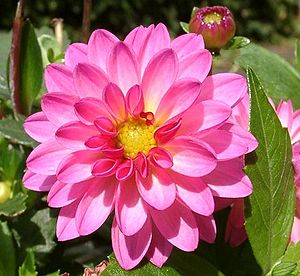Dahlia
| Dahlia | |
|---|---|
 | |
| Genus: | Dahlia |
| Family: | Asteraceae |
| Type: | Tender perennials |
| Pollination: | Insect |
Dahlia is a genus of bushy, summer- and autumn-flowering, tuberous perennials that are originally from Mexico, where they are the national flower.
Description
editIn 1872 a box of Dahlia roots were sent from Mexico to the Netherlands. Only one plant survived the trip, but produced spectacular red flowers with pointed petals. Nurserymen bred from this plant, which was named Dahlia juarezii with parents of Dahlias discovered earlier and these are the progenitors of all modern Dahlia hybrids. Ever since, plant breeders have been actively breeding Dahlias to produce thousands of cultivars, usually chosen for their stunning and brightly coloured flowers. Dahlia plants range in height from as low as 12" (30 cm) to as tall as 6–8 feet (180–240 cm). The flowers can be as small as 2" (5 cm) or up to a foot (30 cm) in diameter. The great variety results from Dahlias being octoploids (they have eight sets of homologous chromosomes, whereas most plants have only two).
Growing conditions
editVarieties
editUses
editMaintenance
editPropagation
editHarvesting
editPests and diseases
editDahlias are used as food plants by the larvae of some Lepidoptera species including Angle Shades, Common Swift, Ghost Moth and Large Yellow Underwing. Crown Gall
- Agrobacterium tumeifasciens
- Pseudomonas solanacearum
Rot (Bacteriosis)
- Erwinnia carotovora
- Erysiphe cichoracearum
- Erysiphe polygoni
- Botrytis cinerea
- Fusarium
- Verticillium albo-atrum
- Pellicularia filamentosa
- Pellicularia rolfsii
- Pythium debaryanum
- Pythium oedochilum
- Pythium ultimum
- Sclerotinia sclerotiorum
- Entyloma dahliae: Dahlia Smut
- Impatiens Necrotic Spot Virus
- Tomato Spotted Wilt Virus
- Cucumber Mosaic Virus
- Dahlia Mosaic Virus
- Meliodgyne haple
- Meliodgyne incognita
- Potato Rot Nematode: Ditylenchus destructor:
- Buckthorn Aphid: Aphis nasturtii
- Bean Aphid: Aphis fabae
- Foxglove Aphid: Acyrthosiphon solani
- Green Peach Aphid: Myzus persicae
- Leaf Curling Plum Aphid: Brachycaudus helichrysi
- Melon Aphid: Aphis gossypii
- Rose Leafhopper: Edwardsiana rosa
- Leafhopper: Empoascus fabae
- Treehopper: Entylia carinata
- Potato Leafhopper: Empoasca fabae
- Citrus Mealybug: Planococcus citri
- Greenhouse Whitefly: Trialeurodes vaporariorum
- Mulberry Whitefly: Tetraleurodes mori
- Silverleaf Whitefly: Bemisia argentifolii
- Capsid Bugs
- Fourlined Plant Bug: Poecilocapsus lineatus
- Tarnished Plant Bug: Lygus lineolaris
- European Earwig: Forficula auricularia
- Greenhouse Thrips: Heliothrips haemorrhoidalis
- Flower Thrips: Frankliniella thricti
- Tobacco Thrips: Frankliniella fusca
- Onion Thrips: Thrips tabaci
- Blister Beetles: Epicauta spp.:
- Spotted Cucumber Beetle: Diabrotica undecimipunctata
- Japanese Beetle: Popillia japonica
- Oriental Beetle: Exomala orientalis
- Rose Chafer: Macrodactylus subspinosus
- Burdock Borer: Papaipema arctivorens
- Corn Earworm: Heliothis zea
- European Corn Borer: Ostrinia nubilalis
- Greenhouse Leaf Tier: Udea rubigalis
- Saddleback Caterpillar: Sibine stimulea
- Stalk Borer: Papaipema nebris
- Giant Hornet: Vespa crabro germana
- Broad Mite: Polyphagotarsonemus latus
- Bulb Mite: Rhizoglyphus echinopus
- Cyclamen Mite: Steneotarsonemus pallidus
- Two-Spotted Spider Mite: Tetranychus urticae